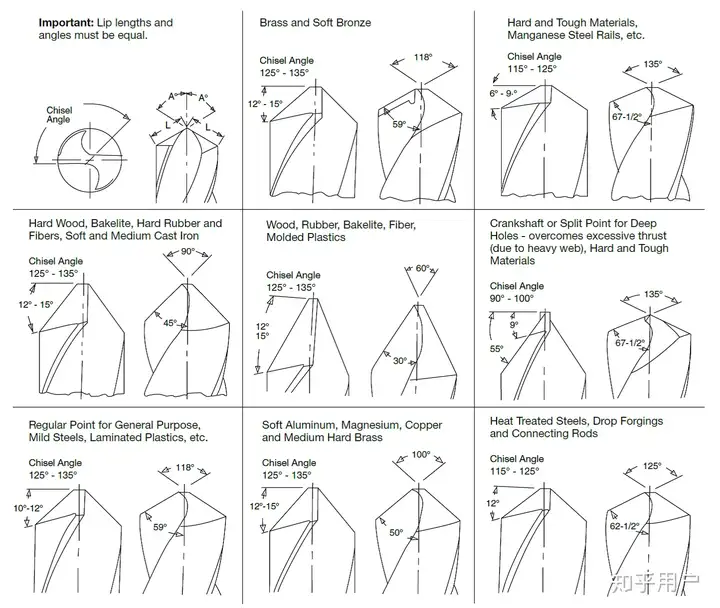动力头钻盲孔最后为什么要钻一个118度的圆锥孔
2022-11-21
著作权归作者所有。商业转载请联系作者获得授权,非商业转载请注明出处。
先说结论,大致118°这个角度的动力头钻头在钻削多数材料时性能都不错,但是考虑到生产和设计钻头的方便,选定了118°,因为59°正切值比较接近0.6,容易计算测量。120°只是直觉上的圆整,但三角函数不是线性的。
本来是不想回答动力头加工和钻孔机械设计类的问题的,毕竟不是我目前的方向,很多不懂的要查资料。但是看到其他答案的敷衍,我觉得还是有必要答一下。而且这个问题很有趣,也比较复杂。
其他答案里都提到的一点:盲孔顶角的角度是由118°顶角的钻头决定的。这个是正确的。因而题主的问题就可以转化为:为什么麻花钻的钻头顶角是118°而不是120°?其他几个答案都没有继续解释了,这跟没回答一样。
首先,“标准理论角度“并不是一个可以信服的答案。维基百科中介绍麻花钻历史时提到:”The most common twist drill bit (sold in general hardware stores) has a point angle of 118 degrees, acceptable for use in wood, metal, plastic, and most other materials, although it does not perform as well as using the optimum angle for each material. In most materials it does not tend to wander or dig in.” 这就是说,在动力头钻削大多数材料时,118°钻头顶角的表现都和针对每种材料的最优顶角的表现相近。因而在很多情况下就统一为了118°。而且麻花钻发明于1861年,118°钻头顶角纳入标准是1920年,那时候没有计算机没有有限元分析,可能测量手段也不支持对钻削过程有足够的认识,所以计算一个最优理论角度在那个年代应该是不太现实的。
既然性能差距不大,那么统一的顶角标准就能很大程度地简化制造钻头和钻削加工的复杂度。但是为什么不选120°呢?下面这个答案是从生产钻头的角度解释的,我觉得非常有道理:
”118 vs. a round number like 120, as both are close to the optimum compromise for commonly drilled metals of the day, one will note 1/tan (59 deg) = 0.601 (essentially 0.60) whereas 1/tan (60) = 0.577…
If you multiply the radius of the drill by 0.6 (or, easier, the diameter by 0.3) you get the length of the conic tip in a blind hole to within 0.014% e.g. within 0.0002″ for a 1/2″ dia drill. Easy to calculate w/o a calculator, while the functional difference was trivial. OTOH, in manual drafting, the cone angle would be drawn using a 30-60 triangle, as no one was going to scale the drawing for the exact value.“ Why 118? Why 135? (Drill angle)
也就是说,尽管120°比118°看起来更加圆整,但是tan(59°)=0.601可以近似为0.60,而tan(60°)=0.577,近似为0.60的误差就比较大了。而在生产和检测钻头的时候,计算和测量钻头的钻尖高度和钻头直径显然是比测量顶角角度更容易。
但是并非所有麻花钻都是118°顶角的,比较常用的是118°和135°,各种角度也都有,毕竟工艺水平提升了,生产多种不同角度的钻头也不再困难了:

而且,不是所有盲孔都会有顶角,一个比较极端的例子是用电镀金刚石钻头,可以用来加工陶瓷和玻璃材料的盲孔:










